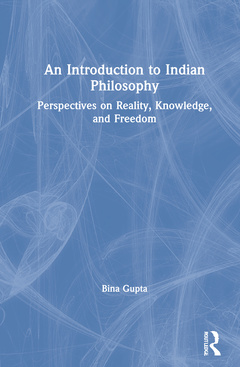Description
An Introduction to Indian Philosophy (2nd Ed.)
Perspectives on Reality, Knowledge, and Freedom
Author: Gupta Bina
Language: English
Subject for An Introduction to Indian Philosophy:
Keywords
Indian Philosophy; Follow; sense; Held; organ; Sense Organ; advaita; Verbal Testimony; vedanta; Pure Consciousness; thought; Darśana; verbal; Wandered; testimony; Vow; vedic; Vedic Hymns; text; Indian Thought; ika; Dependent Origination; Sanskrit-based Vedanta scholarship; Vedic Texts; Philosophic issues; Timeless; Classical darsanas; Karma Yoga; Reborn; India's philosophical tradition; Rebirth; Sūtras; Sense Object Contact; Agnostic; Erroneous Cognition; Universal Concomitance; Finite Individuals; Deep Sleep State; Finest Essence
Approximative price 160.25 €
In Print (Delivery period: 14 days).
Add to cartPublication date: 04-2021
· 15.2x22.9 cm · Hardback
Publication date: 04-2021
· 15.2x22.9 cm · Paperback
Description
/li>Contents
/li>Readership
/li>Biography
/li>
An Introduction to Indian Philosophy offers a profound yet accessible survey of the development of India?s philosophical tradition. Beginning with the formation of Br?hma?ical, Jaina, Materialist, and Buddhist traditions, Bina Gupta guides the reader through the classical schools of Indian thought, culminating in a look at how these traditions inform Indian philosophy and society in modern times. Offering translations from source texts and clear explanations of philosophical terms, this text provides a rigorous overview of Indian philosophical contributions to epistemology, metaphysics, philosophy of language, and ethics. This is a must-read for anyone seeking a reliable and illuminating introduction to Indian philosophy.
Key Updates in the Second Edition
- Reorganized into seven parts and fifteen chapters, making it easier for instructors to assign chapters for a semester-long course.
- Continues to introduce systems historically, but focuses on new key questions and issues within each system.
- Details new arguments, counter-arguments, objections, and their reformulations in the nine schools of Indian philosophy.
- Offers expanded discussion of how various schools of Indian philosophy are engaged with each other.
- Highlights key concepts and adds new grey boxes to explain selected key concepts.
- Includes a new section that problematizes the Western notion of "philosophy."
- New Suggested Readings sections are placed at the end of each chapter, which include recommended translations, a bibliography of important works, and pertinent recent scholarship for each school.
- Adds a new part (Part III) that explains the difficulties involved in translating from Sanskrit into English, discusses fundamental concepts and conceptual distinctions often used to present Indian philosophy to Western students, and reviews important features and maxims that most dar?anas follow.
- Provides new examples of applications to illustrate more obscure concepts and principles.
Part I: Introduction 1. Introduction Part II: The Foundations 2. The Beginnings of Indian Philosophy: The Vedas 3. The Upaniṣads Part III: Darśanas: Preliminary Considerations 4. Darśanas: Preliminary Considerations Part IV: Non-Vedic Darśanas 5. Indian Materialism:The Lokāyata/Cārvāka Darśana and the Śramaṇas 6.The Jaina Darśana 7. The Bauddha Darśana Part V: The Ancient Darśanas 8. The Mīmāṃsa Darśana 9.The Sāṁkhya Darśana 10. The Yoga Darśana 11. The Vaiśeṣika Darśana 12.The Nyāya Darśana Part VI: Systems with Global Impact 13. The Buddhist Schools 14. The Vedānta Darśana Part VII: The Bhagavad Gītā 15. The Bhagavad Gītā Part VIII: Modern Indian Thought 16.Modern Indian Thought Appendix: Translation of Selected Texts A: The Foundations B: Non-Vedic Darśanas C: Ancient Darśanas D: Systems with Global Impact
Bina Gupta is Curators’ Research Professor Emerita at the University of Missouri-Columbia and Affiliated Faculty, South Asian Studies, University of Pennsylvania.




